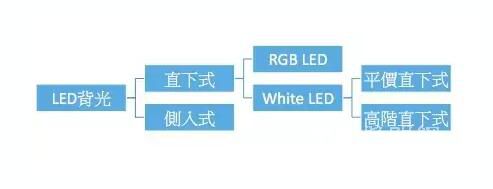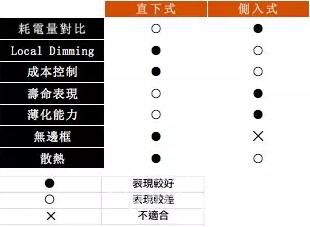A few days ago, I was rushing to say that OLED said VR. Today, Snowy feels that the atmosphere is good. I want to be nostalgic with everyone and talk about the old backlights.
Introduce the life of the backlight LED: the word backlight is produced after the LCD, LCD is a very wonderful thing, the history of discovery has been more than 100 years, just remember one thing, that is, the emergence of LCD has changed the entire display industry, Replacing the CRT that has been in charge for decades has become the beginning of the Flat Panel Display (FPD). The crystal characteristics of the liquid crystal are very special. It is possible to achieve the light and dark and gray scale control of the tiny interval by voltage. The liquid crystal itself is not illuminated. It can be thought of as a gate for controlling light in and out, and an additional light source is needed to match it. The word "backlight" came to life, and because the liquid crystal gave up the role of light, with the appearance of high-brightness blue LEDs, LEDs stepped through the bodies of CCFL, opening up the era of large output.
Before the backlight application was turned on, the LED was only a small supporting role in the electronics industry. It was a bitter wife. It was a cheap indicator or digital display between the black card and the white card. The LED was hard at the time but the LED did not say until one day. When I met the contemporary heroes LCD, he looked at the LED with emotion and said: "In fact, I have been inconsistent with CCFL. CCFL consumes electricity and contains mercury. Considering eugenics, I think we are born with a pair!" Let the LEDs sway, from 2009 to 2012, develop rapidly, desperately improve brightness, efficiency and reduce costs. The application has also been used to kill TV from mobile phones and laptops. The LED's momentum is unstoppable, and the CCFL is hit by a family. In the end, it disappeared completely, and the LED that won the victory became a new favorite of the multi-billion dollar electronics industry. Therefore, when we look back at the LED footprint, we must not forget the backlight, because the backlight is the cradle for the production value of LED, and it is the LED technology. Propeller.
The backlight technology has two branches - "straight down" and "side-in", subdivided as follows:

The side-in design is like the CCFL in the early years. The LED Light Bar is placed on the side and the light is guided through the light guide to the entire plane. The direct type is placed on the bottom of the backlight module through the Lens and layers. The optical film realizes the entire surface light source. The early LEDs were launched in RGB direct mode. The main color is the wider color gamut than CCFL. The representative is the 46-inch TV that Sony and Lumileds cooperated with. Then Blue Chip+Yellow phosphor became popular high-efficiency LED. The low-cost route, which wins in the highly price-sensitive consumer electronics market, slowly replaces the side-entry type and becomes the mainstream of TV backlight design. At the same time, the high-density direct-down type is transferred to the high-end market and arranged in high density. (commonly known as the starry sky) to achieve Local Dimming control technology, and high-end thin side-entry style courts.

Straight-down and side-in contrasts have been played by many people. There are occasional differences in the comparison of certain characteristics, which makes the pure children look psychologically tangled! In fact, all the characteristics difference can be summarized into two reasons: (1) The path of light: At first glance, it is just a turn to speak straight down and side entry, but Snow is not to be considered deep, the position and path of the light source, indeed derived from many technical and external constraints; (2) LED specifications: LED is The main character of the supply light source is a medium power flat package. The current mainstream specifications are 7020 and 4014, the power is 0.5~0.8W, and the direct type is high power 3030, and the power can reach 2W or more. Think of the "path of light" and "LED specification" as the root cause of the difference in the characteristics of the direct side entry. Everything becomes intuitive and simple. The main differences are as follows:

power consumption
The reason is very simple, how do you not need to use a few more than the direct side, that is, the high power LED's lm/W is lower than the medium power, so that now the 3030 is compared with 7020, the latter is about 25% power saving, change In other words, as long as 75% of the electricity is supplied, the same luminous flux can be output. The luminous flux here refers to the luminous flux supplied by the LED. Considering the light transmittance of the display, it is more complicated, and will not be discussed here.
Local Dimming
Although the side entry can be hard, but the local dimming (LCD TV backlight area adjustment technology) still let the direct type come! The direct type of light does not need to turn, after the density of the LED is increased, the partition light and dark can be realized by the individual control of the LED directly. It can be said that the traditional backlight and micro LED transition practice, in fact, Sony exhibited the new model XBR Z9D at CES, in this way to steal the word micro LED, and strive to create the image of the micro LED leader.
Cost Control
Straight down can be very expensive, but in order to achieve the same display brightness (nits), the direct type is definitely cheaper than the side-in type, the cost side has three main reasons: (1) direct-type high-power LED, single 3030 brightness is almost It is twice the 7020, and the price difference is less than 20%, so the LM/$ of 3030 is better than 7020; (2) The side entry type must make the light turn, and the light guide plate is expensive, the cost structure of the backlight module The light guide plate and the LED are comparable. In the medium size application, the light guide plate is even more expensive than the LED; (3) the side-entry frame cost is higher than the direct type, and the gap can be doubled. Based on three reasons, the straight-down style is elegantly won in the battle of cost, and there is no suspense in the side-entry style.
Life performance
Although no one has mentioned this matter, the side-entry life win-win type is the last word. The original reason is still LED. The direct-down type is high-power LED. People who do LEDs naturally understand that feeding LED high current can be exchanged for high. Lumens value, but the cost is efficiency and longevity, just like signing a contract with the devil. In addition to the life of the LED itself, the side-entry LED has an advantage, that is, it is more suitable for use with KSF. The wide color gamut war has been the key topic of display, and the heat directly affects the life and stability of KSF. High-power use, the cost and difficulty can be imagined.
Industrial design flexibility
In the high-end market, the pursuit is not only practical, but also looks like the industrial design of the tide, the local tyrant is very capricious, they will always be willing to pay more "face value premium", so "ultra-thin" and "no border" "It appeared, and this battle went straight into the next city." Straight down to reduce the OD (optical distance), reduce the OD will increase the number of particles, which is not only contrary to the goal of cost down, high-order direct-down type can not catch the limit of the side-entry type with a thin light guide; No borders... This is very intuitive, there is no place next to you, you can only put it behind!
Heat dissipation
Although the direct type is high power and the side input type is medium power. Intuitively, there is more heat generated directly under the direct, but in fact, the direct type pitch is very large, and the heat is not a problem. The side entry type is to change the brightness by the number, resulting in the LED. The distance between the LED and the LED is very small, the heat is concentrated together, and the heat dissipation becomes very important. This also generates the heat dissipation cost. For example, the side-in type TV must use MCPCB, and the direct type only uses the low-order single-sided copper FR4. Enough.
The above
There are no way to completely destroy the other side, but the direct type still has the upper hand. In addition to the absolute advantage of cost, the high-end market also has two weapons, Local Dimming and no border, which leads to the side. The ultra-thin design of the input type cannot be fully won. At present, the direct input ratio of the TV is about 7:3. I think the above comprehensive comparison can explain everything. Saying that I have a good friend called Sam, he blushed when he listened to me explaining this. He murmured that he prefers side-entry, because I didn’t talk to Sam for several days.
Editor: Yingzi
Fiber Optic Transceivers
100G QSFP28 , 100G CFP , 40G QSFP+ , 16G / 25G / 40G / 50G / 100G Transceivers
Chengdu Xinruixin Optical Communication Technology Co.,Ltd , https://www.xrxoptic.com